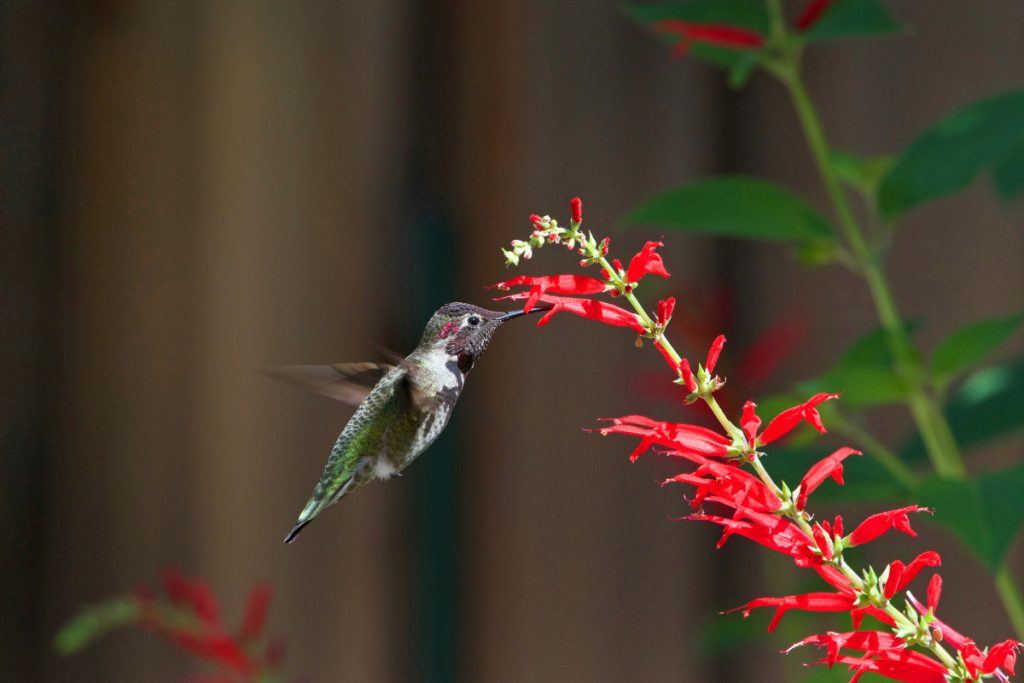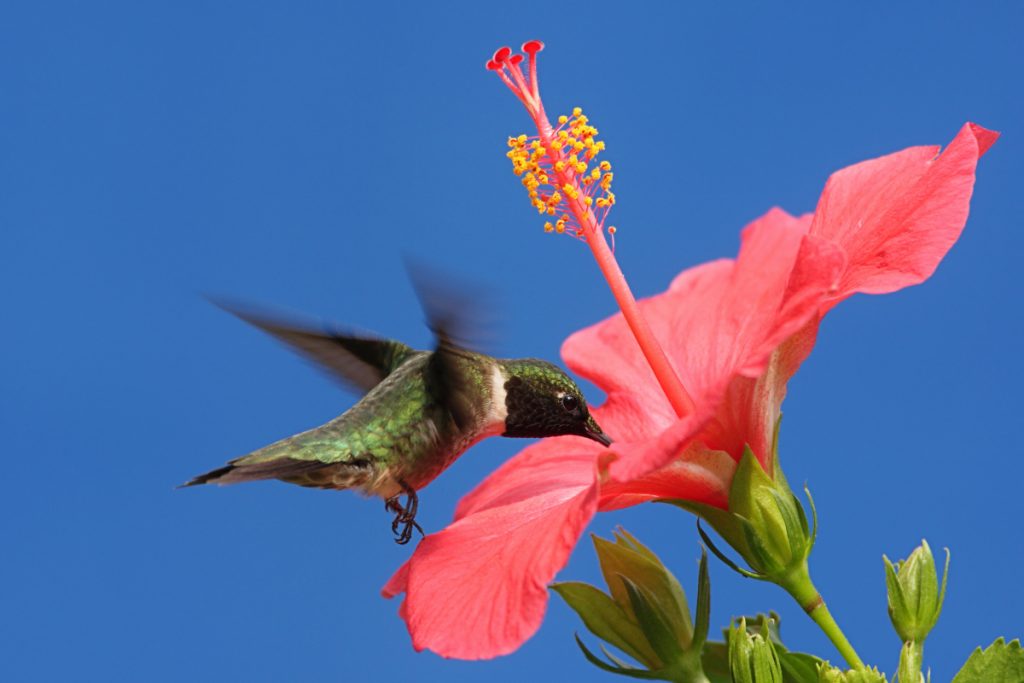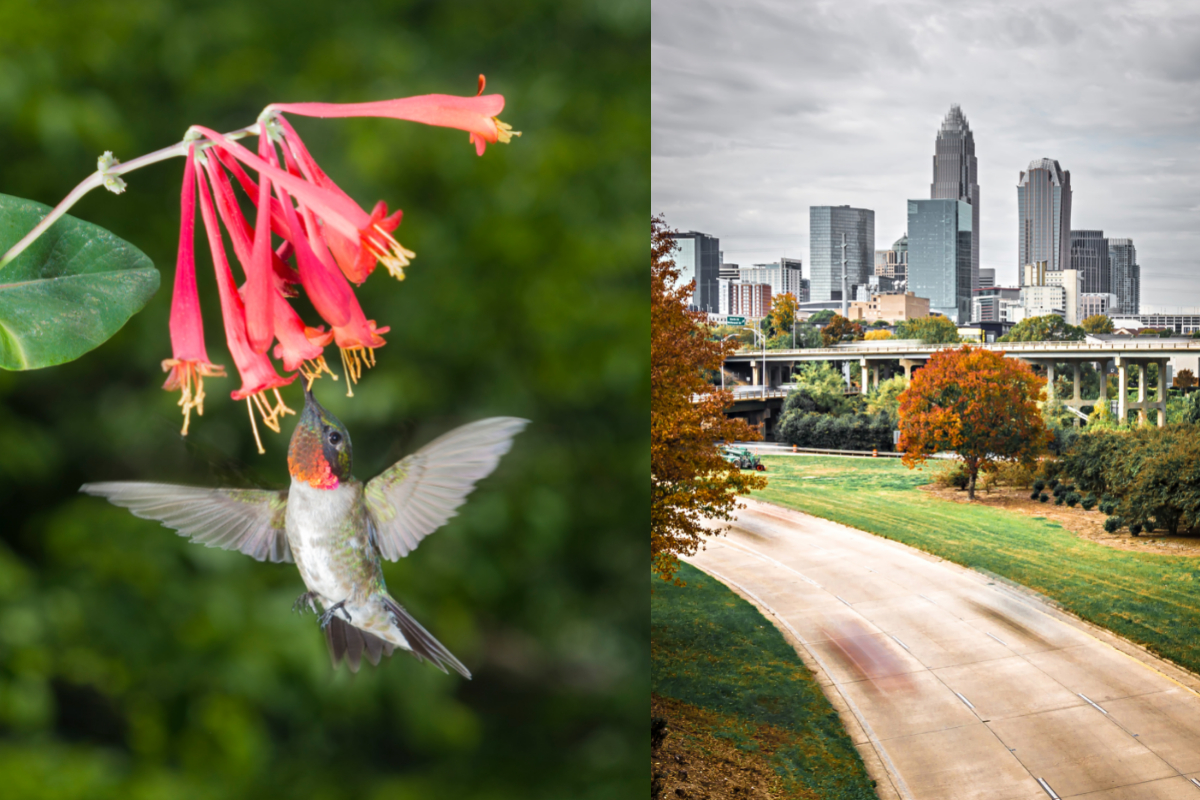Hummingbirds are tiny birds famous for their long migrant journeys. Every year, during spring and summer, they visit many states in the United States to build nests, find food, and even breed.
But as the temperature begins to drop, so do their food sources. Therefore, they leave these states to find warmer climates where they can survive the winter. One of the states in the US that hummingbirds visit yearly is North Carolina.
North Carolina, often referred to as the Tar Heel State is situated in the Southeastern part of the United States. It has a humid climate with very hot summers and relatively cold winters. This climate makes North Carolina an ideal refuge for hummingbirds that migrate there in the spring and summer seasons.
If you’re a bird lover in NC, then you’ll understand the importance of being updated on the arrival and departure of these delightful birds. So, in this blog post, I will be discussing the yearly migration of hummingbirds. This will guide you in preparing for their arrival and departure every year.
When Do Hummingbirds Leave North Carolina?
Hummingbirds begin their departure from North Carolina as summer ends, with the migration spread across early fall. The earliest birds start leaving in August, while others delay their journey until September.
By mid-October, the majority of these migrating hummingbirds would have left the state. This departure coincides with the reduction of their food sources and the onset of colder weather, which challenges their survival in North Carolina.

Related post to read: 25 Hummingbird Behaviors.
- When Do Hummingbirds Leave North Carolina?
- Why Do Hummingbirds Leave North Carolina?
- What Kinds Of Hummingbirds Are Commonly Found In North Carolina?
- Where Can You Find Hummingbirds In North Carolina?
- When Do Hummingbirds Arrive In North Carolina?
- Do The Migration Patterns Of Hummingbirds In North Carolina Change?
- Does the Timing of Hummingbird Sightings Vary in Different Parts of North Carolina?
- How To Prepare For The Arrival Of Hummingbirds In North Carolina
- What Kinds Of Plants Should Be Grown To Attract Hummingbirds In North Carolina?
- Can You Attract Hummingbirds With Feeders In North Carolina?
- When Should You Put Out Your Hummingbird Feeders In North Carolina?
- When Should Hummingbird Feeders Be Taken Down In North Carolina?
- Where Do North Carolina Hummingbirds Go In The Winter?
- Can You Find Hummingbirds In North Carolina During Winter?
- Conclusion
- Useful Links:

Why Do Hummingbirds Leave North Carolina?
As warm-blooded migrant birds, hummingbirds are always seeking warmer climates where they can find an abundance of their food source.
Personally, I find their instinctive migration to be really impressive. These birds have internal clocks known as circadian rhythm that tell them when to leave any state they’re visiting.
Another reason why they leave North Carolina is food availability. As winter approaches, their primary food source dries up, so they travel to warmer climates where their food source is in abundance.
Climate change also influences their departure from North Carolina. As I mentioned earlier, these birds are warm-blooded and can’t survive the freezing winter temperatures.

What Kinds Of Hummingbirds Are Commonly Found In North Carolina?
Out of over 300 species of hummingbirds that migrate globally, the only native species you can find breeding and nesting in North Carolina is the Ruby-throated species. This species is predominant in many eastern states in North America, like Virginia, Delaware, South Carolina, Illinois, Kansas, Florida, etc.
The Rufous species is also a common species in North Carolina. It is the most common species found in the east of the Mississippi River.
The other species visiting North Carolina sometimes include the Black-chinned, Buff-bellied, and Broad-billed hummingbirds. Meanwhile, the Broad-tailed, Anna’s, Allen’s, Green Violet-ear, Calliope, and Green-breasted Mango hummingbirds are rare in the state.
Where Can You Find Hummingbirds In North Carolina?
Some of the best locations for sighting hummingbirds in North Carolina are the Pisgah National Forest, the Appalachian Trail, and the Beech Mountain.
You can also find them in parks like the Hanging Rock State Park and the Great Smoky Mountains National Park.

When Do Hummingbirds Arrive In North Carolina?
With the onset of spring, North Carolina welcomes the arrival of hummingbirds. These vibrant birds typically start appearing in early April, signalling the beginning of their presence in the state.
Their migration pattern is unique, as they don’t travel in large groups. The male species make their way to North Carolina in mid-April to establish their breeding territories. Following them, the female hummingbirds arrive about two weeks later, towards the end of April or in early May, to join their male counterparts.
Do The Migration Patterns Of Hummingbirds In North Carolina Change?
Yes, the migration patterns of hummingbirds in North Carolina changed. Actually, predicting their travel pattern is quite tricky because they have different travel routes and speeds.
Flying from Central and South America, some stronger male species fly for up to 2 days directly to North Carolina over the Gulf of Mexico. Others take the coastal route through Texas, sometimes stopping at people’s backyard feeders to rest and eat before continuing their journey. This journey can take up to a month.
In essence, they arrive and depart from North Carolina at different times, not altogether.
Aside from their travel routes and speed, other factors that can influence their migration patterns are weather conditions and food availability.
Does the Timing of Hummingbird Sightings Vary in Different Parts of North Carolina?
Yes, the arrival time in different regions of the state varies. As solo migrants, they exhibit varying timing patterns.
Usually, residents of the Southern regions of North Carolina get to see hummingbirds earlier than those in the Northern areas. This is due to the warmer climate in the Southern parts of the state.

How To Prepare For The Arrival Of Hummingbirds In North Carolina
Hummingbirds are pollinators and are drawn to plants that are pollen-friendly. To prepare your backyard in North Carolina for their arrival, start planting native plants.
Growing a diverse array of flowers with different bloom times ensures a continuous supply of fresh nectar for hummingbirds.
To keep your garden hummingbird-friendly, avoid using pesticides or insecticides, as they can harm hummingbirds’ food sources. Instead, use only organic pest control methods for cultivation.

What Kinds Of Plants Should Be Grown To Attract Hummingbirds In North Carolina?
Rather than growing imported plants, native flowers like lupines, columbines, petunias, trumpet honeysuckle, bee balm, penstemon, red cardinal flower, rhododendron, and lily should be planted.
These plants are rich in nectar, making them a great choice for attracting hummingbirds in North Carolina.
Related post to read: Hummingbird Diet and Nutrition.
Can You Attract Hummingbirds With Feeders In North Carolina?
Yes, you can attract hummingbirds with feeders in N.C! Just in case you’re a bird lover who doesn’t have backyard space to grow nectar-rich plants that provide their primary food source -nectar, don’t worry: feeders are a great alternative.
The feeders should be filled with a simple sugar-water solution. All you need to make this solution is a cup of sugar with about 4 cups of water. Commercial pre-made nectar for feeders can be bought from stores if you don’t want to prepare the solution yourself.
Once you have prepared your solution, fill it up in the feeders and hang it outside your apartment window.
Artificial nectars only serve as a form of supplement because they don’t provide hummingbirds with the nutrients that natural nectar does.
Keep in mind that you’re not exempted from providing hummingbird feeders, even if you already have a backyard full of native plants. As a matter of fact, it is best to provide a variety of feeding options for hummingbirds since they are territorial birds.
To keep your feeder content safe for your special visitors, remember to change the solution every few days, especially in warm weather, as sugar solutions can ferment quickly.

When Should You Put Out Your Hummingbird Feeders In North Carolina?
Hummingbird feeders can be put out in early April to welcome early migrating hummingbirds in North Carolina. This timing ensures that you’re ready to welcome these delightful birds as they make their seasonal return.
When Should Hummingbird Feeders Be Taken Down In North Carolina?
If you haven’t seen any hummingbirds at your feeders for at least two weeks, you can take them down in the winter when they migrate from North Carolina.
On the other hand, you can still leave them out to help late stragglers migrating south from nearby states.
Related post to read about Best Hummingbird Feeders.
Where Do North Carolina Hummingbirds Go In The Winter?
When migrating hummingbirds leave North Carolina, they embark on a journey southward, making their way to countries in Central and South America, seeking winter habitats that suit their needs.

Can You Find Hummingbirds In North Carolina During Winter?
While most migrating species migrate south for the winter, some choose to remain in North Carolina for the winter, thanks to its mild winter temperatures. So, it’s not exactly uncommon to find hummingbirds in the state during the winter.
Conclusion
Even though the migration patterns of these birds are not predictable, the timeline in this blog post is a reasonable estimate of when they’ll arrive and depart from North Carolina. You don’t have to do too much to please these birds.
Simply provide food sources and shelters for them to feed and rest when they come to visit. And if you’re lucky, they might return to your yard on their next visit.
Until next time, happy bird watching.
Useful Links:
Related Posts to Read – Hummingbirds Migrations:
- When Do Hummingbirds Leave Ohio?
- When Do Hummingbirds Leave Michigan?
- When Do Hummingbirds Leave Pennsylvania?
- When Do Hummingbirds Leave Florida?
- When Do Hummingbirds Leave Oregon?
- When Do Hummingbirds Leave New York?
- When Do Hummingbirds Leave Oklahoma?
- When Do Hummingbirds Leave Minnesota?
- When Do Hummingbirds Leave South Carolina?
- When Do Hummingbirds Leave Louisiana?
- When Do Hummingbirds Leave Virginia?
- When Do Hummingbirds Leave Texas?
- When Do Hummingbirds Leave Indiana?
- When Do Hummingbirds Leave Colorado?
- When Do Hummingbirds Leave Wisconsin?
- When Do Hummingbirds Leave California?
- When Do Hummingbirds Leave Rhode Island?
Related Posts to Read:
- Hummingbird Diet and Nutrition
- Do Hummingbirds Beaks Open When Feeding?
- The Mysteries of Hummingbird Flight.
- 6 Fascinating Facts About Hummingbird Sizes.
- Ruby-Throated Hummingbird Migration Map.
- Where Do Hummingbirds Go When It Rains?
- How Much Does A Hummingbird Eat Per Day?
References:
- About North Carolina.
- About Hummingbird (Link).
- Greenewalt, C. H. (1960). Hummingbirds. New York: Doubleday. Google Scholar.
- Carey C. The impacts of climate change on the annual cycles of birds. Philos Trans R Soc Lond B Biol Sci. 2009 Nov 27; 364(1534):3321-30. doi: 10.1098/rstb.2009.0182. PMID: 19833644; PMCID: PMC2781852.
- Rico-Guevara A, Rubega MA, Hurme KJ, Dudley R. Shifting Paradigms in the Mechanics of Nectar Extraction and Hummingbird Bill Morphology. Integr Org Biol. 2019 Jan 2;1(1):oby006. doi: 10.1093/iob/oby006. PMID: 33791513; PMCID: PMC7671138.
- Tyrrell LP, Goller B, Moore BA, Altshuler DL, Fernández-Juricic E. The Orientation of Visual Space from the Perspective of Hummingbirds. Front Neurosci. 2018 Jan 30;12:16. doi: 10.3389/fnins.2018.00016. PMID: 29440985; PMCID: PMC5797624.
- Hummingbirds Sighting (Journey North Map).
- About Hummingbird’s Characteristics.
